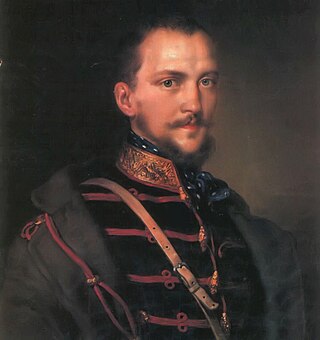
Artúr Görgei de Görgő et Toporc was a Hungarian military leader renowned for being one of the greatest generals of the Hungarian Revolutionary Army.

Count Lajos Batthyány de Németújvár was the first Prime Minister of Hungary. He was born in Pozsony on 10 February 1807, and was executed by firing squad in Pest on 6 October 1849, the same day as the 13 Martyrs of Arad.

Józef Zachariasz Bem was a Polish engineer and general, an Ottoman pasha and a national hero of Poland and Hungary, and a figure intertwined with other European patriotic movements. Like Tadeusz Kościuszko and Jan Henryk Dąbrowski, Bem fought outside Poland's borders anywhere his leadership and military skills were needed.

György (Móric) Klapka was a Hungarian general. He was one of the most important Hungarian generals of the Hungarian War of Independence of 1848–1849, politician, member of the Hungarian Parliament, and deputy War Minister.
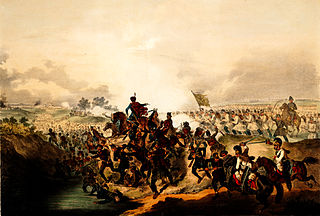
The Battle of Temesvár was a key battle in the Hungarian Revolution of 1848, fought on 9 August 1849 between the Austrian Empire, led by Field Marshal Julius Jacob von Haynau, and the Hungarian Revolutionary Army, led by Lieutenant General Józef Bem. Hungarian forces under Bem, together with siege corps led by Major General Károly Vécsey, totalled 55,000 soldiers. Austrian forces under Haynau totalled 38,000 soldiers, although their numerical disadvantage was mitigated by superior artillery. The battle resulted in an Austrian victory and was the decisive engagement of the war, which ended in defeat for the Hungarians.
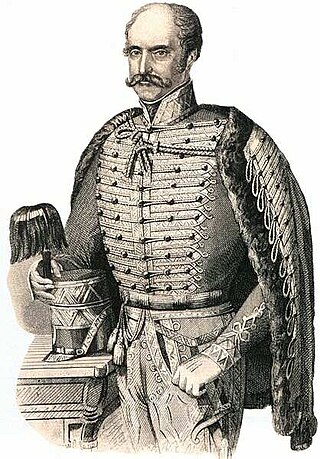
General Lázár Mészáros(English: Lazarus Mészáros), was the Minister of War during the 1848 Hungarian Revolution.

Lajos Aulich was the third Minister of War of the Hungarian State.

The Hungarian Revolution of 1848, also known in Hungary as Hungarian Revolution and War of Independence of 1848–1849 was one of many European Revolutions of 1848 and was closely linked to other revolutions of 1848 in the Habsburg areas. Although the revolution failed, it is one of the most significant events in Hungary's modern history, forming the cornerstone of modern Hungarian national identity—the anniversary of the Revolution's outbreak, 15 March, is one of Hungary's three national holidays.
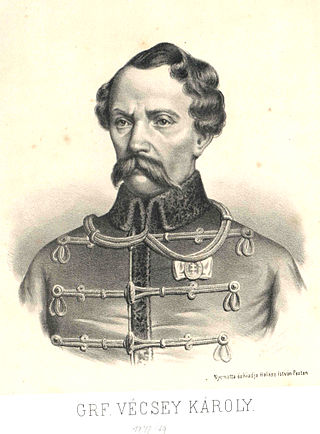
Count Károly Vécsey de Hernádvécse et Hajnácskő was a honvéd general in the Hungarian Army. He was executed for his part in the Hungarian Revolution of 1848, and is considered one of the 13 Martyrs of Arad.
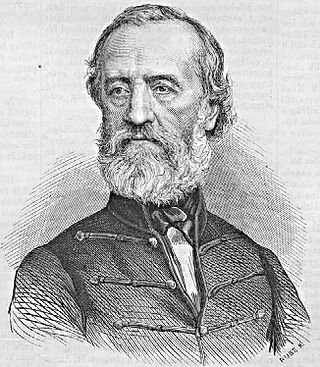
Sir Mór Perczel de Bonyhád, was a Hungarian landholder, general, and one of the leaders of the Hungarian Revolution of 1848.

The Battle of Schwechat was a battle in the Hungarian war of Independence of 1848-1849, fought on 30 October 1848 between the revolutionary Hungarian Army led by Lieutenant General János Móga against the army of the Austrian Empire led by Lieutenant General Josip Jelačić, at Schwechat, near Vienna. This was the last battle of 1848 in the Transdanubian campaign. The Hungarian Army wanted to relieve the revolutionaries from Vienna, besieged by the Austrian imperial army, but they were defeated. Vienna fell on the next day.

György Kmety was a general in the Hungarian Army, and in the Ottoman Army under the name Ismail Pasha.

The Battle of Isaszeg took place in the Spring Campaign of the Hungarian War of Independence from 1848 to 1849, between the Austrian Empire and the Hungarian Revolutionary Army supplemented by Polish volunteers. The Austrian forces were led by Field Marshal Alfred I, Prince of Windisch-Grätz and the Hungarians by General Artúr Görgei. The battle was one of the turning points of the Hungarian War of Independence, being the decisive engagement of the so-called Gödöllő operation, and closing the first phase of the Spring Campaign.

The Battle of Kishegyes was a battle in the Hungarian Revolution of 1848. It was fought between the Hungarian Revolutionary Army and the Habsburg Corps from July 11 to 15, 1849. The Hungarian Revolutionary Army was under the command of Antal Vetter and Richard Guyon, while the Habsburg Corps was under the Ban of Croatia's Lieutenant Field Marshal, Josip Jelačić, in alliance with the Croatian and Serbian units. Jelačić, wanting to surprise the Hungarians with a night attack, accidentally ran into their positions. Soon afterwards, Hungarian troops attacked Jelačić's army, defeating it and forcing it to retreat to the Titel plateau, which was fortified by the Serbians. As a result, the Hungarian forces retook regions from Bácska, lost after the Battle of Káty, and gained territory back after the initiative on the Southern front.

András Gáspár was a Hungarian general who fought in the Hungarian War of Independence of 1848–1849.

The Battle of Tápióbicske was a battle in the Spring Campaign of the Hungarian War of Independence (1848–1849), fought on 4 April 1849 between the Austrian Empire and the Hungarian Revolutionary Army. The Habsburg forces consisted of the I Corps of the Imperial Army led by Lieutenant Field Marshal Josip Jelačić. The Hungarians deployed I and III Corps led by General György Klapka and General János Damjanich respectively. Although initially the careless soldiers of the I. corps were put to flight by the Croatian and Austrian soldiers, after entering in their trap, the Hungarians were victorious, thanks to the intervention of the III. corps, and the main Hungarian armies could advance towards the Hungarian capitals, forcing the Austrian high commander, Field Marshal Alfred I, Prince of Windisch-Grätz fight a decisive battle at Isaszeg, which would decide the fate of Central and Western Hungary until the intervention of the Russian forces on the Habsburg side in June 1849.

The First battle of Komárom was one of the most important battles of the Hungarian War of Independence, fought on 26 April 1849, between the Hungarian and the Austrian Imperial main armies, which some consider ended as a Hungarian victory, while others say that actually it was undecided. This battle was part of the Hungarian Spring Campaign. After the revolutionary army attacked and broke the Austrian siege of the fortress, the Imperials, having received reinforcements which made them numerically very superior to their enemies, successfully counterattacked, but after stabilising their situation, they retreated towards Győr, leaving the trenches and much of their siege artillery in Hungarian hands. By this battle the Hungarian revolutionary army relieved the fortress of Komárom from a very long imperial siege, and forced the enemy to retreat to the westernmost margin of the Kingdom of Hungary. After this battle, following a long debate among the Hungarian military and political leaders about whether to continue their advance towards Vienna, the Habsburg capital, or towards the Hungarian capital, Buda, whose fortress was still held by the Austrians, the second option was chosen.

The Battle of Vác, fought between 15 and 17 July 1849, was one of two important battles which took place in Vác during the Hungarian War of Independence. This battle, fought between the Russian Empire's intervention forces led by Field Marshal Ivan Paskevichand and the Hungarian Army of the Upper Danube led by General Artúr Görgei, was part of the Summer Campaign. After the lost battle of Komárom from 11 July 1849, Görgei tried to lead his army to the planned concentration point of the Hungarian troops around Szeged, but the Russians cut his road at Vác. In the battle, the still convalescent Görgei managed to capture Vác from the Russians, repulse the Russian attacks, then to retreat towards North-East, as much superior Russian forces arrived. Fearing that Görgei will cut their supply lines, after the battle, the four times bigger Russian army, instead of marching towards Szeged in order to unite with the Austrian main army of Field Marshal Julius Jacob von Haynau, and to crush the much weaker Hungarian forces which were gathering there, followed Görgei's retreating troops, enabling them to arrive to the Hungarian concentration point with several days in front of them, creating the condition to unite with the Southern Hungarian troops, and crush the Austrian army of Haynau before the Russians arrived. Considering the fact that the actual plan of Görgei was to arrive to the concentration point before the Russians, and, as a result of the battle of Vác from 15 to 17 July, he managed to achieve this, this battle is considered a strategic victory for the Hungarians.

The Battle of Káty was fought between the Hungarian IV corps led by General Mór Perczel and the Austrian and Croatian soldiers of the Southern Army led by the Ban of Croatia Lieutenant Field Marshal Josip Jelačić, as part of the fight for Southern Hungary, consisting of the Bácska, Bánság and Slavonia provinces, at 7 June 1849, as part of the Summer Campaign of the 1848-1849 Hungarian Revolution of 1848 and Freedom War. Fought between two equal sized armies, the Hungarians suffered a nearly catastrophic defeat, failing to occupy the Southern regions, losing the initiative gained in the Spring Campaign. However, after the battle, Jelačić did not profit from his victory, by trying to crush the weakened Hungarians, but retreated, enabling them to reorganize.
The Battle of Ihász took place during the Summer Campaign of the Hungarian War of Independence. It was fought on 27 June 1849 around and in Ihász, a formerly existing village, today part of Marcaltő. In this battle, the Hungarian division led by General György Kmety fought against the Austrian Gerstner brigade led by Lieutenant General Adolf Schütte Edler von Warensberg. During the preparations for the Battle of Győr, the Gerstner brigade wanted to cut the Hungarians from the south, by attacking Marcaltő, but the Kmety division attacked them and halted their advance for 2 hours with its artillery, but the attack of the Austrian cavalry forced the Hungarians to retreat towards Pápa. A result of this battle was that the Kmety division was forced to retreat in Southern Hungary, so it could not support the Hungarian main army led by General Artúr Görgei in the very important battles for Győr and Komárom.



















